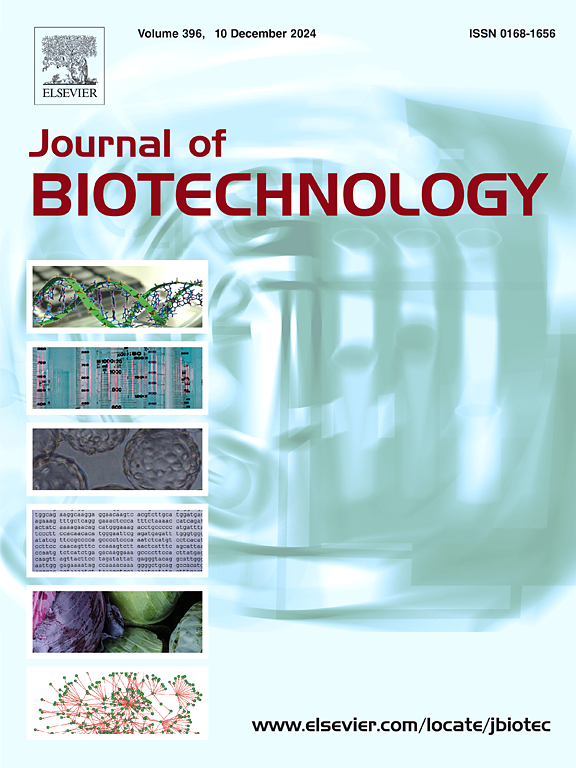环端双链RNA在植物中增强外源RNAi。
IF 3.9
2区 生物学
Q2 BIOTECHNOLOGY & APPLIED MICROBIOLOGY
引用次数: 0
摘要
外源RNA干扰(exoRNAi)已成为植物基因沉默的一种很有前途的工具,但一种强大而有效的exoRNAi技术仍然难以实现。在这里,我们评估了环端dsRNA (ledRNA)设计以增强exoRNAi的疗效。ledRNA具有哑铃状结构,由单链环两侧的长dsRNA茎组成,dsRNA茎上有一个缺口位点。当局部施用于叶片、子叶、分生组织或根时,在处理组织(叶、子叶、根)和未处理组织(邻近叶区和远端子叶和根)中,ledRNA的积累水平均高于传统发夹RNA (hpRNA)。这表明,与传统的RNAi分子相比,ledRNA在植物中具有更大的稳定性和更有效的吸收和运动。局部传递的ledRNA诱导了benthamiana叶片中内源FAD2基因的更强沉默,导致单不饱和脂肪酸的积累增加。除了植物之外,ledRNA在不同的生物王国中也表现出RNAi活性。当引入尖孢镰刀菌培养物时,ledRNA有效且特异性地下调真菌细胞中FoCYP51A、FoCYP51B、FoCYP51C、FoSDHB、FoSDHC和FoSDHD基因的表达。此外,青桃蚜虫(Myzus persicae)口服靶向关键MpRack-1基因的ledRNA显著降低了它们的繁殖力,导致后代产量下降75%。这些发现强调了ledRNA作为一种有前途的工具,可以增强基于exornai的基因表达操作的功效。本文章由计算机程序翻译,如有差异,请以英文原文为准。
Enhanced exogenous RNAi by loop-ended double-stranded RNA in plants
Exogenous RNA interference (exoRNAi) has emerged as a promising tool for gene silencing in plants, yet a robust and efficient exoRNAi technology remains elusive. Here we evaluated a Loop-ended dsRNA (ledRNA) design for enhancing exoRNAi efficacy. ledRNA has a dumbbell-like structure, consisting of a long dsRNA stem flanked by single-stranded loops, with a nick site at the dsRNA stem. When topically applied to leaves, cotyledons, meristems or roots, the ledRNA accumulated at higher levels than traditional hairpin RNA (hpRNA) both in the treated tissues (leaf, cotyledon, roots) and untreated tissues (adjacent leaf areas and remote cotyledons and roots). This suggests that ledRNA possesses greater stability and more efficient uptake and movement in plants than the traditional RNAi molecules. Topically delivered ledRNA induced stronger silencing of the endogenous FAD2 gene in N. benthamiana leaves, leading to increased accumulation of monounsaturated fatty acids. Beyond plants, ledRNA also exhibited RNAi activity in diverse kingdoms of life. When introduced into cultures of the fungus Fusarium oxysporum, ledRNA effectively and specifically downregulated expression of the FoCYP51A, FoCYP51B, FoCYP51C, FoSDHB, FoSDHC and FoSDHD genes in the fungal cells. Additionally, oral ingestion of ledRNA targeting the critical MpRack-1 gene by green peach aphids (Myzus persicae) significantly reduced their fecundity, leading to a 75 % decrease in progeny production. These findings highlight ledRNA as a promising tool for enhancing the efficacy of exoRNAi-based manipulation of gene expression.
求助全文
通过发布文献求助,成功后即可免费获取论文全文。
去求助
来源期刊

Journal of biotechnology
工程技术-生物工程与应用微生物
CiteScore
8.90
自引率
2.40%
发文量
190
审稿时长
45 days
期刊介绍:
The Journal of Biotechnology has an open access mirror journal, the Journal of Biotechnology: X, sharing the same aims and scope, editorial team, submission system and rigorous peer review.
The Journal provides a medium for the rapid publication of both full-length articles and short communications on novel and innovative aspects of biotechnology. The Journal will accept papers ranging from genetic or molecular biological positions to those covering biochemical, chemical or bioprocess engineering aspects as well as computer application of new software concepts, provided that in each case the material is directly relevant to biotechnological systems. Papers presenting information of a multidisciplinary nature that would not be suitable for publication in a journal devoted to a single discipline, are particularly welcome.
 求助内容:
求助内容: 应助结果提醒方式:
应助结果提醒方式:


